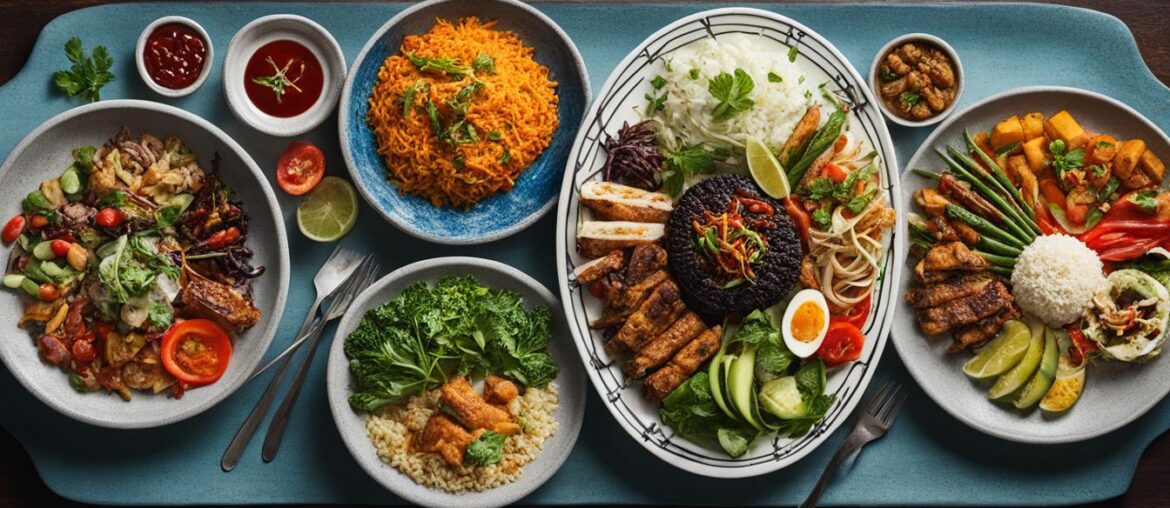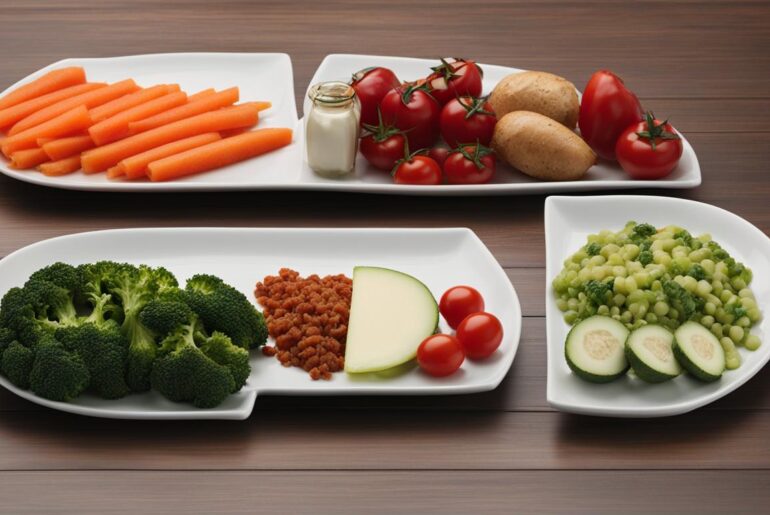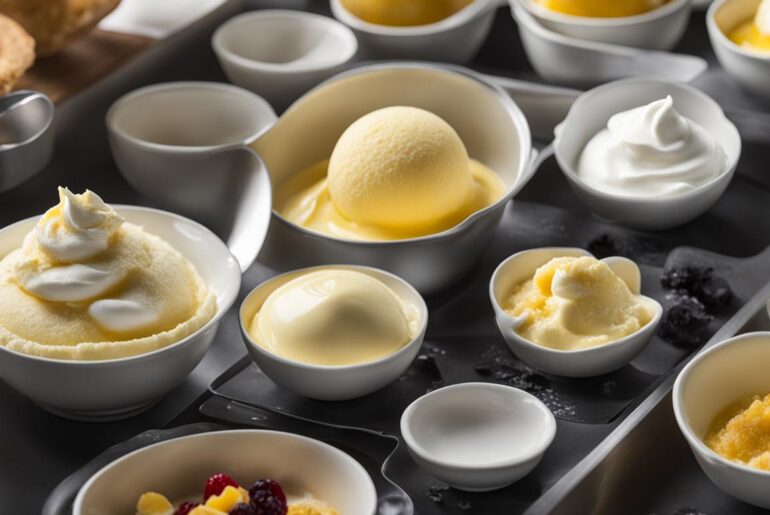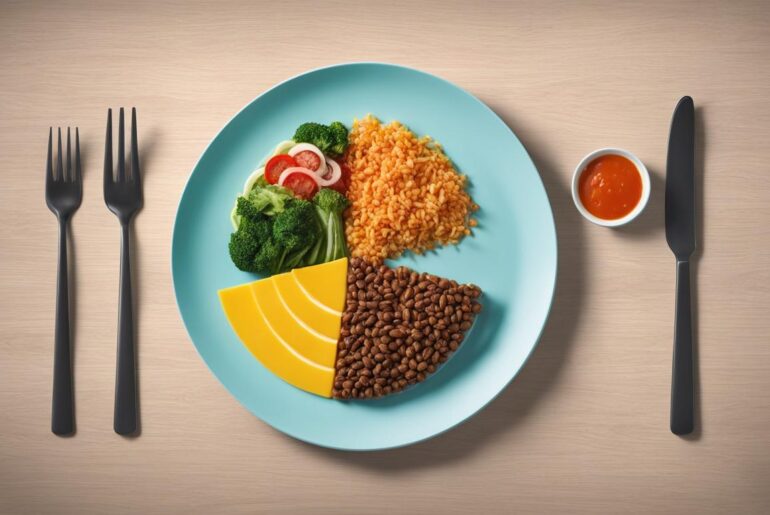In today’s world, portion sizes of our favorite foods have been increasing steadily over time. Ultrarised foods and beverages are now being sold in sizes that are up to five times larger than when they were first introduced. Unfortunately, regularly consuming large portions can lead to negative health consequences, including obesity. This is where portion control comes in. Mastering portion control is essential for weight management and overall health.
Key Takeaways:
- Understanding the importance of portion control for weight management and overall health
- The conscious decision to consume an appropriate and balanced amount of food
- Challenges such as emotional eating and portion distortion in portion control
- Practical tips for portion control at home, such as using smaller plates and pre-portioning meals
- Awareness of portion control in different cuisines and making mindful choices
Understanding Portion Control and its Importance
In order to maintain a balanced diet and effective weight management, understanding portion control is crucial. Portion control involves consciously deciding to consume an appropriate amount of food to meet nutritional needs without overindulging. It plays a significant role in preventing overeating and promoting a healthier relationship with food.
One of the main benefits of portion control is its impact on weight management (check this post out). By consuming appropriate portion sizes, individuals can ensure they are neither consuming too many calories nor depriving themselves of essential nutrients. This can help prevent weight gain and contribute to maintaining a healthy weight.
Portion control also helps individuals develop a better understanding and control of their eating habits. It encourages mindfulness and awareness of the body’s satiety cues, allowing individuals to differentiate between physical hunger and emotional eating. Many people struggle with overeating due to emotional triggers, such as stress or boredom. Practicing portion control can minimize the likelihood of succumbing to these triggers and promote a healthier approach to eating.
“Portion control promotes a healthier relationship with food and encourages mindful eating habits.”
It is important to note that portion distortion is a common challenge in portion control. In today’s society, larger portion sizes have become the norm, making it easy to lose sight of what a healthy portion actually looks like. This can lead to overeating without individuals being aware of it. By actively practicing portion control, individuals can recalibrate their understanding of portion sizes and make more informed choices about the food they consume.
By adopting portion control as a lifestyle habit, individuals can maintain a balanced diet, manage their weight effectively, and prevent the negative consequences of overeating. The next section will provide practical tips on how to incorporate portion control into your daily life, particularly when preparing and consuming food at home.
Practical Tips for Portion Control at Home
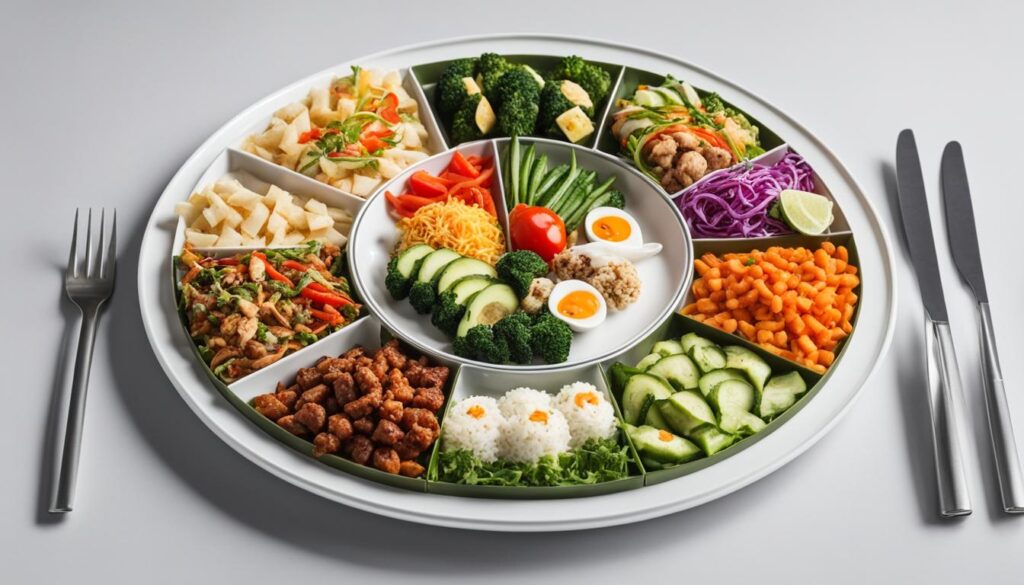
Incorporating portion control into your daily routine can significantly contribute to maintaining a healthy diet and managing your weight. By being mindful of the portion sizes you consume, you can avoid overeating and achieve a balanced lifestyle. Here are some practical tips to help you with portion control at home:
- Use smaller plates and bowls: Opt for smaller dishware when serving your meals. The visual perception of a full plate can create the illusion of a larger portion, satisfying your mind while still consuming an appropriate amount of food.
- Measure and weigh ingredients: When cooking or preparing meals, make use of measuring cups, spoons, and kitchen scales to accurately portion out your ingredients. This ensures that you are not unknowingly consuming more than you intended.
- Pre-portion snacks and meals: Take the time to pre-portion your snacks and meals before consuming them. This can prevent mindless eating and help you stick to your desired portion sizes.
By implementing these simple strategies, you can maintain better control over your portion sizes and avoid overeating. Remember to be mindful of your portion sizes while cooking or preparing food. Embrace the practice of portion control as a step towards a healthier lifestyle.
To further illustrate the benefits of portion control, let’s take a look at a comparison between regular plates and smaller plates:
| Regular Plate | Small Plate |
|---|---|
| Allows for larger portions | Creates the perception of a full plate |
| Potential for overeating | Promotes portion control |
| May lead to excessive calorie intake | Helps in consuming appropriate portions |
As you can see, opting for smaller plates can be an effective visual strategy to control your portion sizes. It can help you maintain a balanced and mindful approach to eating.
Stay tuned for the next section, where we will explore portion control in different cuisines and how you can practice it while enjoying diverse global flavors!
Portion Control in Different Cuisines
When it comes to portion control, it’s important to understand that it can be practiced in various cuisines around the world. Each cuisine has its own traditional portion sizes and healthy eating practices. By being aware of these typical portion sizes and making mindful choices, individuals can enjoy flavorful meals while maintaining portion control and healthy eating habits.
Let’s take a closer look at how portion control can be implemented in some popular global cuisines:
1. Mediterranean Cuisine
Mediterranean cuisine, known for its emphasis on fresh ingredients and vibrant flavors, offers a balanced approach to portion control. Meals typically include a variety of vegetables, whole grains, lean proteins, and healthy fats such as olive oil. By following the Mediterranean diet, which focuses on natural and unprocessed foods, individuals can manage portion sizes effectively while enjoying a diverse range of nutritious dishes.
2. Japanese Cuisine
Japanese cuisine, renowned for its exquisite presentation and meticulous attention to detail, provides an excellent example of portion control. Traditional Japanese meals often consist of smaller portions of different dishes, including steamed rice, miso soup, fish, and vegetables. The use of smaller plates and bowls further promotes mindful eating and helps individuals manage their portion sizes.
3. Indian Cuisine
Indian cuisine is rich in flavors and spices, but portion control can be challenging due to the temptation to overindulge in decadent dishes. However, by focusing on home-cooked meals and including a variety of vegetables, lentils, and whole grains, individuals can practice portion control while still savoring the vibrant tastes of Indian cuisine. Balancing the plate with a smaller portion of rice and larger portions of vegetables and protein is a key strategy for controlling portion sizes.
4. Mexican Cuisine
Mexican cuisine offers a wide array of flavorful dishes, but portion control can be a concern, especially with popular items like tacos and burritos. Opting for smaller tortillas and filling them with a generous amount of vegetables, lean proteins, and salsa can help manage portion sizes. Additionally, incorporating side dishes like grilled vegetables or salads can further enhance the nutritional value of the meal while keeping portions in check.
5. Thai Cuisine
Thai cuisine is known for its bold flavors and aromatic spices. To practice portion control while enjoying Thai food, choosing dishes that are stir-fried or steamed instead of deep-fried can help reduce unnecessary calories. Moderation is key when it comes to incorporating coconut milk and condiments high in sodium, like fish sauce. Opting for smaller portions and balancing the meal with a variety of vegetables and proteins can support portion control and healthy eating.
By understanding portion control practices in different cuisines, individuals can make informed choices when dining out or preparing meals at home. Implementing these strategies helps maintain portion control, supports weight management, and contributes to overall healthy eating habits (check out my post on healthy eating habits here).
Portion Control Tools and Resources
When it comes to portion control, having the right tools and resources can make a significant difference in managing portion sizes and maintaining a balanced diet (check this post out). Here are some essential tools and methods that can support your portion control journey:
Portion Control Plates
Portion control plates are specially designed dishes that help you measure your food portions accurately. These plates typically have divided sections, each indicating the recommended portion sizes for different food groups (check out my post on recommended portion sizes here). By using portion control plates, you can visually guide yourself to consume the right amount of each food group to achieve a balanced meal (check out my post on portion control plates here). This not only helps control portion sizes but also ensures you are getting the necessary nutrients.
Portion Control Containers
Another useful tool for portion control is the portion control containers. These containers come in various sizes and are specifically designed to hold predetermined portions of different food groups. By filling these containers with your meals and snacks, you can easily control portion sizes and avoid overeating. With portion control containers, you can plan and prep your meals in advance, making portion control more convenient and efficient.
Portion Control Methods
In addition to using plates and containers, there are several effective portion control methods that can help you manage portion sizes:
- Use visual cues: Visual cues, such as comparing portion sizes to familiar objects or your hand size, can serve as a helpful guide to estimate portion sizes.
- Read food labels: Paying attention to food labels and understanding serving sizes can provide valuable information about portion control.
- Eat mindfully: Practicing mindful eating can help you become more aware of your hunger and fullness cues, leading to better portion control.
- Avoid distractions: Eating in front of the television or while working can lead to overeating. Focus on your meal and savor each bite.
By incorporating these tools and methods into your daily routine, you can effectively manage portion sizes and achieve your healthy eating goals.
Remember, portion control is a valuable skill that promotes weight management and overall health. Combining these tools and methods with a mindful approach to eating can empower you to make positive choices and maintain a balanced lifestyle.
| Portion Control Tools and Resources: | Benefits: |
|---|---|
| Portion Control Plates | – Visual guide for balanced meals |
| Portion Control Containers | – Convenient portion management |
| Portion Control Methods | – Effective strategies for portion control |
Conclusion
Mastering portion control is crucial for maintaining a balanced diet and achieving weight management goals. By understanding the significance of portion control and implementing practical strategies, individuals can enjoy their favorite cuisines while maintaining a healthy lifestyle.
Portion control plays a vital role in weight management as it helps prevent overeating and promotes a healthier relationship with food. By consciously deciding to consume an appropriate amount of food, individuals can avoid the negative consequences of consuming large portions regularly, such as obesity and related health issues.
Overcoming common challenges, such as emotional eating and portion distortion, is essential for successful portion control. Using smaller plates and bowls can visually create the perception of a larger portion, while measuring and weighing ingredients ensures accuracy. Pre-portioning snacks and meals can also prevent overeating, especially when cooking or preparing food at home.
Various tools and resources, including portion control plates, containers, and methods, can help individuals manage portion sizes effectively. These tools assist in measuring and controlling portions, while techniques like visual cues and reading food labels provide additional support for maintaining portion control.
By mastering portion control, individuals can achieve a balanced diet and successfully manage their weight, leading to a healthier lifestyle overall (see my post here). Incorporating portion control into daily routines empowers individuals to make mindful choices about their food consumption, enjoy a variety of cuisines, and prioritize their long-term health and well-being.

